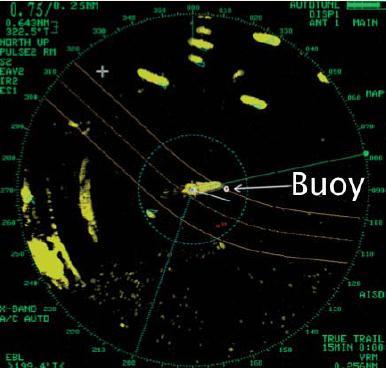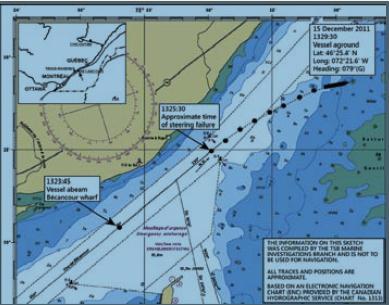201341 Steering failure? Think NFU
Official Report edited from TSB (Canada) M11L0160
The vessel, under pilotage, departed port in ballast and was down bound in a restricted waterway. The engine control was set to bridge control and a helmsman was using manual full follow-up (FFU) steering.
At one point a port alteration was requested; however, the rudder angle indicator showed 10 degrees to starboard. Several port and starboard helm inputs were attempted with the FFU but no rudder movement could be observed on the rudder angle indicator. The pilot then ordered the engine to be stopped and that the anchor be readied.
The Master arrived on the bridge just as the vessel was leaving the buoyed channel. He went directly to the steering stand and transferred the steering system actuator switch from the port system to starboard system. This action restored control to the steering but it was too late. The vessel ran aground at an estimated speed of 8 knots over the ground.
The vessel is fitted with a very typical steering control system where a control mode selector switch is used to select one of three different means of steering the vessel: autopilot, hand (FFU) or non-follow-up (NFU). The helm order data signal to the steering gear telemotors is provided by two potentiometers that are mechanically linked to the helm wheel and electrically linked to each telemotor: one potentiometer per telemotor. It was later discovered that the port system helm follow-up potentiometer had failed, rendering the FFU useless until the starboard system was belatedly selected by the Master.
Typically, when the NFU mode is selected, the NFU controller becomes operational and the helm wheel is deactivated. Additionally on this vessel once the NFU controller is used, it overrides all other steering controllers without the need to set the steering mode selector switch to NFU. The NFU controller is a spring-loaded lever that must be held to one side or the other for a signal to be sent to the steering gear telemotors.
Alternative steering methods
Subsequent to this accident the TSB conducted a review of vessels from different owners and flag states to determine the general knowledge and use of the NFU mode by bridge crew members. Although from a statistically small group, it was nonetheless found that 75% of crew surveyed were not fully familiar with the use of the NFU mode. Generally, familiarisation for helmsmen on joining the vessel included brief explanations of the different steering stand components and their use, including the NFU mode. Furthermore, the procedures for dealing with situations involving steering failures refer primarily to the local emergency steering in the steering gear compartment. Use of the NFU mode, if it is referred to, is usually listed as a secondary or tertiary method to regain control.
When the bridge team became aware that the rudder was not responding, three options were available on the bridge to rectify the situation:
1 taking over the steering control with the non-follow-up (NFU) mode,
2 changing over from the port to the starboard steering system to also regain steering control, or
3 stopping the vessel.
However, stopping the vessel was not a viable option because of the vessel’s proximity to the shore and the length of time required to put the engine at full astern and stop the vessel and or anchor effectively. Thus, while in this case the engine was ordered full astern, the engine went astern only after the vessel had grounded and before the anchor could be deployed.
The other two options in this situation involved regaining control of steering. There was no attempt made by the OOW or the helmsman nor order by the pilot to use the NFU mode or to switch from the port to the starboard steering system. By the time the Master returned to the bridge and switched the steering system selector switch from port to starboard, restoring control of rudder movement, it was too late to prevent the grounding.
Some of the findings of the official report
1 Without the regular replacement of potentiometers, there is an increased risk that they will fail in service.
2 Crew may be unfamiliar with the steering control methods of the non-follow-up mode or switching steering systems in cases of steering failure, if this information is not incorporated into technical manuals, familiarisation, and drills, or adequately described and posted near the steering stand.
Editor’s Note: A steering malfunction in the middle of the ocean is not a problem – you have lots of time and there are no hazards. But typically, in restricted waterways you only have a minute or two to resolve the steering issue before unwanted consequences are suffered.
Many reports and surveys have shown that crew are not instinctively switching to NFU when a steering failure in FFU mode occurs – yet this should be their first reaction. Switching steering systems (port to starboard or vice versa) is also a procedure that takes only a few seconds and could save the situation.


